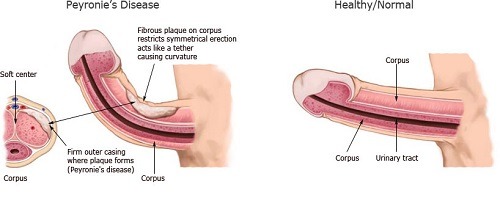Peyronie’s Disease is an unusual condition not often talked about in the male community. It is characterised by the development of fibrous scar tissue inside the penis leading to curved, painful erections that significantly impact the sexual health and quality of life of males of varying ages.
Peyronie’s Disease is an enigmatic and often misunderstood condition. While known to be precipitated by trauma or injury in some cases, this condition often arises without a definitive cause, leading to speculation and uncertainty among patients and the healthcare community. Misinformation often circulates this condition, causing confusion and unnecessary anxiety among people with this condition and those who suspect they may have it.
As such, it’s important to dispel any myths and misconceptions so that people can better understand the condition and reduce the stigma surrounding it. Doing so will encourage affected men to seek medical advice and appropriate treatment.
In this article, we’ll delve into the various myths surrounding Peyronie’s Disease and debunk each one. By the end of this article, you’ll gain clarity and invaluable insights into this condition.

Myth 1: Peyronie’s Disease Can Go Away On Its Own
When faced with the question “Can Peyronie’s Disease go away on its own?” You’ll find that a common hope among those diagnosed is that the condition might resolve itself without any medical intervention. While it’s true that in some cases, symptoms may improve over time, such cases can be rare. The course of Peyronie’s Disease can be unpredictable, with some experiencing worsening symptoms without treatment. It’s best not to leave things to chance. If your symptoms persist for more than four weeks, it’s advisable to consult a urologist for a professional evaluation.
While some individuals with mild symptoms may experience improvement over time, expecting the condition to vanish without treatment completely is often unrealistic for most sufferers. Factors such as symptom severity, pain levels, and the extent of penile curvature significantly influence the disease’s course. In cases where symptoms are mild and not worsening, monitoring may be recommended.
Here are two distinct phases of Peyronie’s disease following its onset: acute and chronic.
1. Acute Phase
During the acute phase, the plaque begins to form, often due to trauma or other factors. This stage typically lasts for 12 to 18 months and may present the following signs:
- Bruising or discolouration may be visible.
- Penile curvature becomes noticeable, particularly during erection.
- Pain may occur during erection and sometimes when the penis is flaccid.
2. Chronic Phase
The chronic phase, which ensues if left untreated, occurs after the plaque has fully formed, typically around 12 to 18 months after the initial symptoms appear. Here’s what can be expected during this phase:
- Penile curvature tends to stabilise, and further plaque formation ceases.
- Pain is likely to diminish.
- Erectile dysfunction (ED) may develop or worsen in some cases.
For individuals facing significant discomfort, sexual dysfunction, or a curvature that impacts daily life, seeking professional medical advice is essential. Without intervention, symptoms may persist unchanged or worsen gradually over time.
Early consultation with a specialist like Dr. Katelaris can lead to better management and outcomes, potentially including the use of oral medications, injections, or physical therapy to reduce symptoms and improve quality of life.
Myth 2: A Curved Erection Means I Have Peyronie’s Disease
It’s not unusual for the penis to exhibit a slight curve to the left or right during erection. Many men have this natural curvature. However, if you experience a pronounced curvature accompanied by discomfort or challenges during sexual intercourse, it’s advisable to consult your urologist as these symptoms may indicate Peyronie’s Disease.
Peyronie’s Disease vs. Normal Curvature
Here’s a chart to help you differentiate the two:
Normal Curvature
- Normal variation where the penis may exhibit a slight curve to the left or right during erection.
- Generally, not accompanied by significant pain or difficulty during sexual intercourse.
- Often does not require medical intervention and does not worsen over time.
Peyronie’s Disease
- Involves a more pronounced and often abnormal curvature of the penis during erection.
- Can cause pain, discomfort, or difficulties with sexual intercourse.
- May progress over time, leading to worsening symptoms and functional impairment.
- Requires medical evaluation and management, including potential treatment options such as medication, injections, traction therapy, or surgery.
Understanding this difference between Peyronie’s disease and a normal curvature of a penis is crucial for seeking appropriate care and not dismissing potential symptoms of Peyronie’s Disease.
Myth 3: Natural Remedies Alone Can Cure Peyronie’s Disease
While there is no scientifically proven Peyronie’s disease “natural treatment,” maintaining a healthy lifestyle is beneficial for one’s overall well-being. Still, despite the lack of evidence, the internet is filled with claims of natural remedies and treatments for Peyronie’s Disease, ranging from dietary supplements to various physical exercises. It’s important to seek professional help to detect the early signs of Peyronie’s disease. For one, a lump in your penis can be an urgent sign to seek medical advice promptly.
Moreover, effective treatment plans often involve a combination of therapies tailored to the individual’s specific condition and symptoms under the guidance of a healthcare professional.
Here are some treatment options that your urologist will suggest based on your specific condition:
- Injections: Injectable treatments such as collagenase, verapamil (a blood pressure medication), and interferon have demonstrated effectiveness when administered directly into the area of scar tissue buildup.
- Non-drug interventions: Mechanical traction devices, penis vacuums, and shockwave therapy are currently being studied to assess their potential in reducing plaque size and restoring the penis’s original shape.
- Surgery: In cases where penis curvature exceeds 50 degrees or if painful erections persist beyond the initial year, surgical intervention may be recommended to excise the plaque.
The different treatment options available aim to relieve pain, reduce curvature, and restore normal function as effectively as possible. Recognising the different cases and severity of Peyronie’s Disease underscores the importance of tailored medical advice.
Myth 4: Only Elderly Men are Affected by Peyronie’s Disease
It’s a misconception that Peyronie’s Disease solely affects older men. While it’s true that this disease is more common among older men, the reality is that it can occur in adult men of any age. However, the prevalence does increase with age. Factors such as genetics, trauma to the penis, and certain health conditions can contribute to the risk of developing Peyronie’s Disease. Recognising that men of all ages can be affected is essential for raising awareness and encouraging those experiencing symptoms to seek medical advice.
Myth 5: Surgery is the Only Option for Treating Peyronie’s Disease
Surgery is often viewed as a last resort for treating Peyronie’s Disease and is typically considered only for severe cases or when other treatments have failed to provide relief. Several non-surgical treatments are available and can be effective, especially in the early stages of the disease. These include oral medications to reduce plaque inflammation and pain, injections directly into the plaque to break down the fibrous tissue, and shockwave therapy to promote blood flow and healing. Each case of Peyronie’s Disease is unique, and treatment plans should be customised to the individual’s specific needs and circumstances.
Final Words
Understanding and effectively managing Peyronie’s Disease begins with dispelling the myths surrounding it. It’s important to recognise that this condition while challenging, is not incurable and can affect males of any age. Throughout this discussion, we’ve aimed to provide clarity on Peyronie’s Disease by challenging misconceptions and reducing stigma. We’ve also highlighted the diverse treatment options available.
It’s crucial for those affected to seek professional guidance rather than rely on hopeful thinking or unverified remedies. Specialists such as those at Katelaris Urology play a vital role in offering evidence-based treatments tailored to individual needs. With informed and compassionate care, Peyronie’s Disease can be managed effectively, allowing for a return to normalcy and well-being.
If you suffer from Peyronie’s Disease or suspect you have it, contact us here to book a consultation with Dr. Katelaris – a Peyronie’s Disease expert with over 30 years experience.







